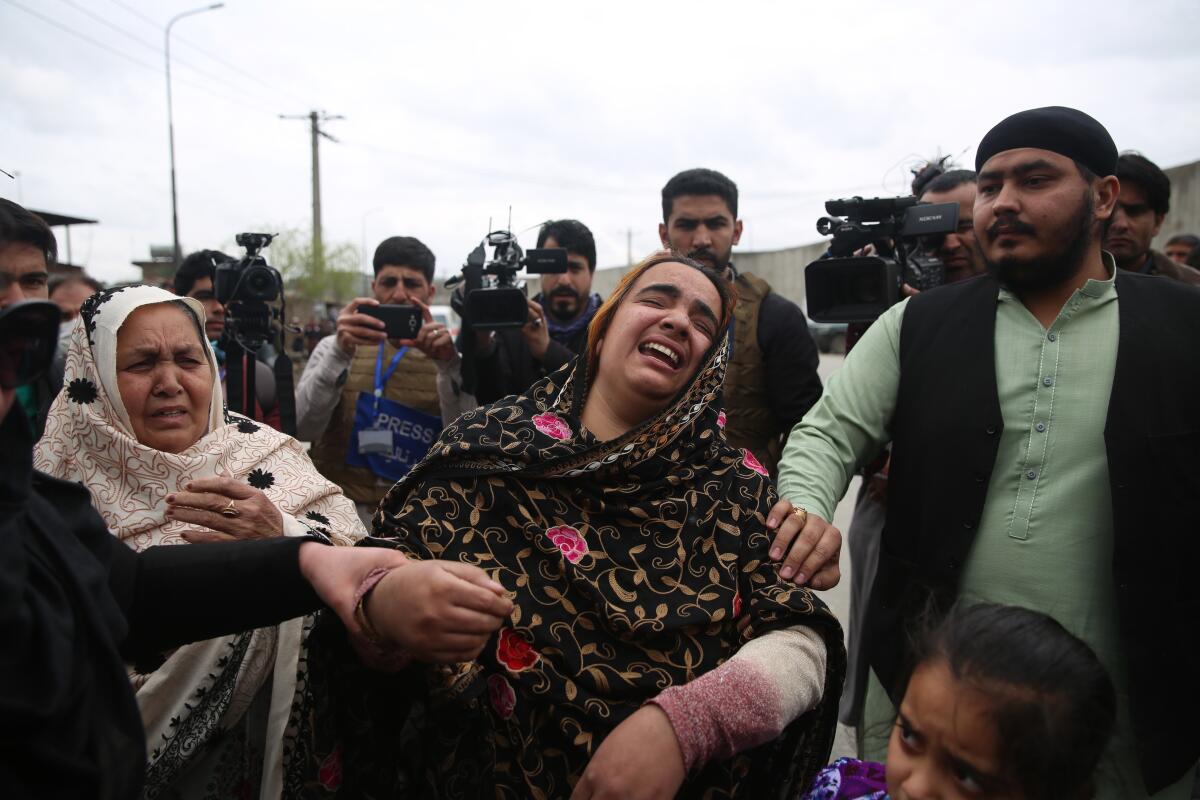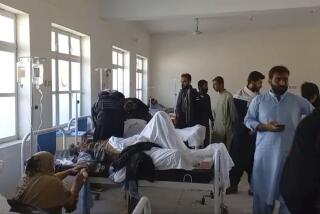Islamic State gunman kills 25 in attack on Sikhs in Kabul

KABUL, Afghanistan â A lone Islamic State gunman rampaged through a Sikh house of worship in the heart of the Afghan capital, Kabul, on Wednesday, killing 25 worshipers and wounding eight, Afghanistanâs Interior Ministry said.
The gunman held many of the worshipers hostage for several hours as Afghan special forces, helped by international troops, tried to clear the building. At least one of the dead was a child.
Within hours, Islamic State claimed responsibility for the attack.
As the siege ended, the Afghan special forces rescued at least 80 worshipers who had been trapped inside the Sikh house of worship, known as a gurdwara, as the gunman lobbed grenades and fired his automatic rifle into the crowd, the ministry said.
Earlier, Afghan lawmaker Narindra Singh Khalsa said he rushed over to help after receiving a call from a worshiper inside the gurdwara telling him of the attack. There were about 150 worshipers inside the gurdwara at the time, he added.
The SITE Intelligence Group, which tracks militant postings and groups, said Islamic State had claimed responsibility for the attack on the groupâs Aamaq media arm.
At a Kabul hospital, Mohan Singh, who was in the gurdwara when the attack began, said he first heard gunshots and ducked for cover under a table. Later he heard the sounds of explosions, adding that he believes they were hand grenades. He was injured when parts of the ceiling fell on him.
In photographs shared by the Interior Ministry, about a dozen children were seen being rushed out of the gurdwara by Afghan special forces, many of them barefoot and crying.
As the news of the attack broke Wednesday, Taliban spokesman Zabihullah Mujahed tweeted that the Taliban were not involved. Earlier this month, Afghanistanâs Islamic State affiliate struck a gathering of minority Shiite Muslims in Kabul, killing 32 people.
Afghanistanâs national security advisor Hamdullah Mohib condemned the attack in a tweet while neighboring Pakistan and India both issued statements of condemnation. Pakistan described the attack as âheinous.â
âSuch despicable acts have no political, religious or moral justification and must be rejected outright,â the Pakistani foreign ministry statement said.
India said the attack was particularly egregious coming as Afghanistan sought to deal with the growing coronavirus outbreak.
âSuch cowardly attacks on the places of religious worship of the minority community,â India said, reflect the âdiabolical mindset of the perpetrators and their backers.â
Sikhs have suffered widespread discrimination in the conservative Muslim country and have also been targeted by Islamic extremists. Under Taliban rule in the late 1990s, they were asked to identify themselves by wearing yellow armbands, but the rule was not enforced. In recent years, large numbers of Sikhs and Hindus have sought asylum in India, which has a Hindu majority and a large Sikh population.
In July 2018, a convoy of Sikhs and Hindus was attacked by an Islamic State suicide bomber as they were on their way to meet Afghan President Ashraf Ghani in the eastern city of Jalalabad, the capital of Nangarhar province. Nineteen people were killed in that attack.
Elsewhere in Afghanistan, at least eight civilians were killed in southern Helmand province when their vehicle hit a roadside mine, said Omer Zwak, spokesman for the provincial governor. The area is under Taliban control but no one took immediate responsibility.
In a separate incident in northern Kapisa province, insurgents opened fire on a vehicle, killing three civilians and a security officer, said Shahiq Shoresh Kohistani, spokesman for the provincial police chief.
Washington signed a deal with the Taliban on Feb. 29 and has begun to withdraw its troops in keeping with the agreement but it has run into trouble as Afghanistanâs political leadership battles relentlessly for power. Two presidents sit in Kabul. Not even a surprise visit by U.S. Secretary of State Michael R. Pompeo on Monday, who threatened to withhold $1 billion in aid if they didnât âget their act together,â could break the impasse.
A glimmer of hope appeared late Wednesday with a tweet from Taliban political spokesman Sohail Shaheen. He said the release of Taliban prisoners â a must before intra-Afghan negotiations can begin â could start by March 31. The decision came after a four-hour videoconference between the Taliban, the government, Washingtonâs peace envoy Zalmay Khalilzad and the Qatari government representative. The Taliban maintain a political office in the Middle Eastern State of Qatar.
The U.S.-Taliban deal calls for the release of 5,000 Taliban prisoners as well as 1,000 government captives as a goodwill gesture to launch intra-Afghan negotiations, but until now Kabul has been resisting the release.
Shaheen also said four Taliban members may travel to the prison at Bagram, north of the Afghan capital Kabul.
With more than 137,000 Afghans returning from Iran so far this year â traveling throughout the country before being tested and without follow-up â there are concerns that the countryâs already war-devastated health system could be overwhelmed.
The United Nations Assistance Mission in Afghanistan on Wednesday called for a âreduction of violence leading to a cease fireâ by all combatants in Afghanistan to better prepare for âthe looming health crisis posed by COVID-19,â and to give a chance to intra-Afghan negotiations between warring groups.
More to Read
Sign up for Essential California
The most important California stories and recommendations in your inbox every morning.
You may occasionally receive promotional content from the Los Angeles Times.










